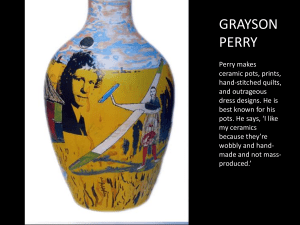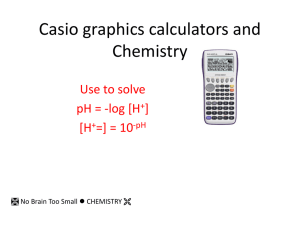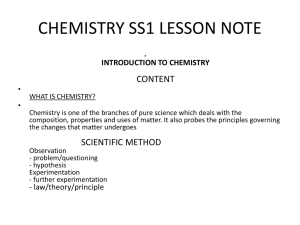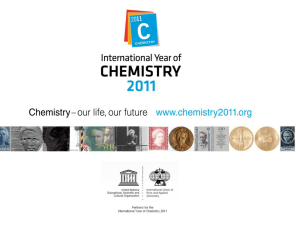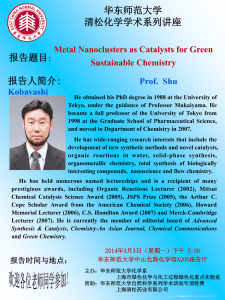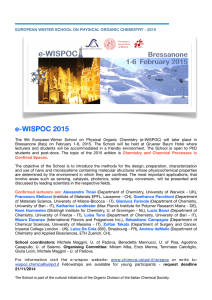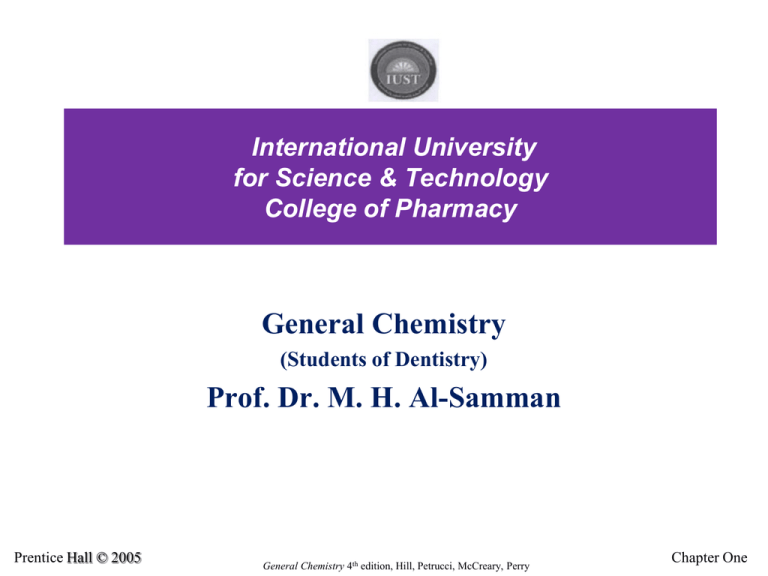
International University
for Science & Technology
College of Pharmacy
General Chemistry
(Students of Dentistry)
Prof. Dr. M. H. Al-Samman
Prentice Hall © 2005
General Chemistry 4th edition, Hill, Petrucci, McCreary, Perry
Chapter One
CHEMISTRY
Chapter 1
Introduction: Matter &
Measurement
Prentice Hall © 2005
General Chemistry 4th edition, Hill, Petrucci, McCreary, Perry
Chapter One
لماذا ندرس علم الكيمياء
يمكن تعريف الكيمياء بأنها علم دراسة خواص المواد والتغيرات التيتطرأ عليها .
ومما الشك فيه فإن دراسة الكيمياء وفهم العمليات الكيميائية هيأساس جوهري لفهمنا لبقية العلوم .
وتدخل الكيمياء في كل مناحي الحياة اليومية لإلنسان ,لذلك حظيتالكيمياء بإهتمام اإلنسان منذ البدايات األولى للتاريخ .
Chapter One
General Chemistry 4th edition, Hill, Petrucci, McCreary, Perry
Prentice Hall © 2005
Chemistry: Catastrophe
Prevention?
The space shuttle Columbia disintegrated in 2003 upon reentry into
the Earth’s atmosphere due to a damaged thermal protection system.
Prentice Hall © 2005
General Chemistry 4th edition, Hill, Petrucci, McCreary, Perry
Chapter One
5
المادة والواحدات:الكيمياء
Prentice Hall © 2005
General Chemistry 4th edition, Hill, Petrucci, McCreary, Perry
Chapter One
6
القياسات العلمية
:جملة الواحدات الدولية
Si ( ويرمز لها بالرمزthe International System of Units)
. وفي جلة الواحدات الدولية هناك واحدة قياس أساسية معتمدة لكل قياس
Prentice Hall © 2005
General Chemistry 4th edition, Hill, Petrucci, McCreary, Perry
Chapter One
7
القياسات العلمية والبدائل األسيةSI Prefixes :
تستخدم البدائل )(SI Prefixesاألسيّة للتعبير عن األس العشري
للواحدات شائعة األستخدام ,والتي
هي أكبر أو أصغر من الواحدة
األساسية .
وعلى الرغم من وجود عدد كبيرمن البدائل األسية الممكنة ,فإن
المستخدم منها هو عدد قليل نسبيا
ولعل الكيلو)(kiloوالسنتي ) (Centi
والميلي )(milliهي األكثر
شيوعا في االستخدام على شكل بدائل
أسيّة .
Chapter One
General Chemistry 4th edition, Hill, Petrucci, McCreary, Perry
Prentice Hall © 2005
8
Unit Conversion:
Conversion Factors
Example: 2.54 cm = 1 in.
We can write two conversion factors:
2.54 cm
––––––– = 1
1 in.
1 in.
––––––– = 1
2.54 cm
• We use these conversion factors to
convert in. to cm and to convert cm to in.
• Multiply the quantity we are given by
the appropriate factor.
• Question: Which factor is used for each
task?
• Answer: Use the one that cancels the
unit we do not need, and leaves the unit
we want.
Prentice Hall © 2005
General Chemistry 4th edition, Hill, Petrucci, McCreary, Perry
Chapter One
9
وعوامل, تحويل الواحدات
التحويل
Example: 2.54 cm = 1 in.
We can write two conversion factors:
2.54 cm
––––––– = 1
1 in.
1 in.
––––––– = 1
2.54 cm
• We use these conversion factors to
convert in. to cm and to convert cm to in.
• Multiply the quantity we are given by
the appropriate factor.
• Question: Which factor is used for each
task?
• Answer: Use the one that cancels the
unit we do not need, and leaves the unit
we want.
Prentice Hall © 2005
General Chemistry 4th edition, Hill, Petrucci, McCreary, Perry
Chapter One
10
Scientific
Measurements
العلمية
القياسات
القياسات العلمية
(Length) الطول
1m=10¹dm=10²cm=10³mm=10⁶μ=10⁹n=10¹²p
1m=10⁻¹da=10⁻²h=10⁻³km=10⁻⁶M=10⁻⁹G
1 in=2.54 cm
1 yard= 91.44 cm
1 foot=30.48 cm
1 mile=176 yard=1609.35 m
Prentice Hall © 2005
General Chemistry 4th edition, Hill, Petrucci, McCreary, Perry
Chapter One
11
Scientific
Measurements
العلمية
القياسات
القياسات العلمية
(Volume) الحجم
1Lit=1000ml or 10³ ml=1000cm³ or 10³ cm³
1ml=1cm³
1 lit=1.057 qt
1 gallon = 3.785 lit
1 fluid ounce (fl oz) = 29.57 ml
(Mass) الكتلة
1kg=10³g=10⁶mg=10⁹ ng=10¹²pic g
1kg=10⁻³ton
1lb=453.6 grams
1ounce (oz) =28.35 g
Prentice Hall © 2005
General Chemistry 4th edition, Hill, Petrucci, McCreary, Perry
Chapter One
12
Scientific
Measurements
العلمية
القياسات
القياسات العلمية
:مثال Example
?What is the length in millimeters of a 1.25-ft rod
ماهو طول قضيب معدني بالميليميتر ,إذا كان طوله 1.25قدم ؟الحل:Answer
أوال ,يتم تحويل طول القضيب من واحدات القدم إلى واحدات السنتيميتر ,ثم يتمالتحويل إلى الميليميتر ,كما هو مب ّين:
1 ft = 30.48 cm = 304.8 mm
The length = 1.25 x 304.8 = 381 mm
Chapter One
General Chemistry 4th edition, Hill, Petrucci, McCreary, Perry
Prentice Hall © 2005
13
Scientific Measurements
القياسات العلمية
:Exampleمثال
حوّ ل كال مما يلي إلى الوحدة المناسبة التي يتم فيها استبدال البديل األسي
:الموافق
(a) 9.56 × 10–3 m
(b) 1.07 × 103 g
Convert the unit of each of the following measurements
to a unit that replaces the power of ten by a prefix.
(a) 9.56 × 10–3 m
(b) 1.07 × 103 g
Answer الحل:
(a)=9.56 mm , (b)=1.07 kg
Prentice Hall © 2005
General Chemistry 4th edition, Hill, Petrucci, McCreary, Perry
Chapter One
14
Scientific
Scientific Measurements
Measurements
القياسات العلمية
Q- We have a cubic metallic sheet of alloy with
dimensions 6 in edge and 4 in thick , in this sheet
there is a vertical cylindrical hole with a 2 in
diameter , if the density of the sheet is 8.79
g/cm³, calculate the mass of the metallic sheet:
1- In grams
2- In ounces (oz).
3- In pounds (lb).
EOS
Prentice Hall © 2005
General Chemistry 4th edition, Hill, Petrucci, McCreary, Perry
Chapter One
15
Scientific
Scientific Measurements
Measurements
القياسات العلمية
سؤال :
لدينا صفيحة من خليطة معدنية مكعبية الشكل ,يبلغ طول ضلع القاعدة 6
انشات وسماكة المكعب 4انش ,يوجد على مدى ارتفاع المكعب ,فجوة
اسطوانية الشكل قطر قاعدتها 2انش ,فإذا كانت كثافة الخليطة المعدنية ,
,8.79 g/cm³أوجد وزن الصفيحة المعدنية :
-1بالجرام
2باالونسة
-3بالليبرة
EOS
Chapter One
General Chemistry 4th edition, Hill, Petrucci, McCreary, Perry
Prentice Hall © 2005
16
الدقة والصحة في القياسات
Precision and Accuracy in Measurements
:Precision الدقة
في قياس ما, هي مقياس إلقتراب القيمة المقاسة من القيم المقاسة األخرى
:Accuracy الصحة أو الصوابية
هي مقياس لمدى اقتراب القيمة المقاسة من القيمة الصحيحة
Darts are close together
(precise) but they aren’t
“bullseyes” (accurate).
Prentice Hall © 2005
Darts are close together
AND they are “bullseyes.”
General Chemistry 4th edition, Hill, Petrucci, McCreary, Perry
Chapter One
17
االرتياب في القياسات
Uncertainty in Measurements
:الشك واالرتياب في القياسات Uncertainty in measurement
من الضروري أن نالحظ أن الدقة والصحة في القياسات تتعلق بشكل رئيسي
بمدى دقة وصوابية األجهزة المستخدمة .
)(depends on the precision and accuracy of the devices.
:مثال For example
الملوث ) (polluted waterأخذ الكيميائي كمية قدرها
,عند تحليل عينة من الماء
ّ
25مليليتر من الماء باستخدام مقياس اسطواني مدّرج ,و ثم أخذ 25.00مليليتر
مدرجة , ,ماهو الفرق بين القياسين باستخدام .
ماصة
ّ
على الرغم مما يالحظ في المثال المب ّين ,بأن القياسيين المختلفين ,يبدوان متمائلين ,فإننانالحظ بسهولة أن االرتياب في القياس األول هو:
1∓مليليتر ,ألن القيمة المقاسة تقع بين 24مل و 26مل
أما االرتياب في القياس الثاني هو:
0,01 ∓ميليليتر ,ألن القيمة المقاسة تفع بين 24.99مل و 25.01مل .
يالحظ أن الشك في القياس األول حوالي 2مل ,بينما الشك في القياسالثاني حوالي 0,02مل .
Prentice Hall © 2005
Chapter One
General Chemistry 4th edition, Hill, Petrucci, McCreary, Perry
قواعد تحديد األرقام الهامة
Rules for Counting Significant Figures
ّ , غير الصفر, كافة األرقام في عدد ما. تمثل قيما هامّة
( 4 significant figures) يملك أربعة أرقام هامّة3456 مثال العدد-
Prentice Hall © 2005
General Chemistry 4th edition, Hill, Petrucci, McCreary, Perry
Chapter One
قواعد تحديد األرقام الهامة
Rules for Counting Significant Figures
•
(There are three classes of zeros.( هناك ثالثة أنواع من األصفار-
Leading zeros األصفار الموج ّههوهي األصفار التي تسبق كل األرقام األخرى ( تقع إلى يساراألرقام
.األخرى ) لئن وجدت فاصلة أم لم توجد
0.048 has 2 sig figs. (since we can write the value as
48x10⁻³).
Prentice Hall © 2005
General Chemistry 4th edition, Hill, Petrucci, McCreary, Perry
Chapter One
قواعد تحديد األرقام
Rules for الهامة
Counting
Significant
Rules for Counting Significant Figures
Figures
Captive zerosاألصفار المحصورة
وهذه األصفار, غير الصفر, وهي االصفار التي تقع بين األرقام الهامة
. تعتبر أرقاما هامة
مثال
16.07 has 4 sig figs.
Prentice Hall © 2005
General Chemistry 4th edition, Hill, Petrucci, McCreary, Perry
Chapter One
قواعد تحديد األرقام الهامة
Rules for Counting Significant Figures
Trailing zeros األصفار الالحقة
نميّز بين نوعين من هذه, وهنا, وهي األرقام التي تقع إلى يمين العدد
ولكن, كانت أرقاما هامة, فإن سبق هذه األصفار فاصلة, األصفار
. بدون وجود فاصلة فهي ليست هامة
:مثال
9.300 has 4 sig figs.
150 has 2 sig figs.( since we can write this value as :
15x10⁺¹)
Prentice Hall © 2005
General Chemistry 4th edition, Hill, Petrucci, McCreary, Perry
Chapter One
قواعد تحديد األرقام الهامة
Rules for Counting Significant Figures
Exact numbers األعداد المعينة
. تملك األعداد المعينة عددا غير محدود من األرقام الهامة
(Exact numbers have an infinite number of significant
figures.).
: مثال
1 inch = 2.54 cm, exactly.
9 pencils (obtained by counting).
Prentice Hall © 2005
General Chemistry 4th edition, Hill, Petrucci, McCreary, Perry
Chapter One
Exponential Notation الداالت األسية
•
Example
300.00 can be written as 3.00 × 102
Contains three significant figures.
Prentice Hall © 2005
General Chemistry 4th edition, Hill, Petrucci, McCreary, Perry
Chapter One
الداالت األسية Exponential Notation
مزايا استخدام األرقام الهامة significant figures
أوال :يمكن االشارة إلى األرقام الهامة بسهولة .
ثانيا :يمكن استخدام عدد قليل من األصفار للتعبير عن أعداد كبيرة جدا
,أو صغيرة جدا.
Chapter One
General Chemistry 4th edition, Hill, Petrucci, McCreary, Perry
Prentice Hall © 2005
Significant Figures in Mathematical Operations
األرقام الهامة في العمليات الرياضية
-في عمليات الضرب , multiplicationاو عمليات القسمة division
يعتبر عدد اآلرقام الهامة المعتمدة في ناتج الحساب ,مساويا ,ألقلعدد من هذه األرقام الموجودة في أحد هذه القياسات .
.مثال:
1.342 × 5.5 = 7.381 7.4
-يالحظ أن العدد الناتج قد ت ّم تدويره إلى الرقم األعلى .
Chapter One
General Chemistry 4th edition, Hill, Petrucci, McCreary, Perry
Prentice Hall © 2005
Significant
FiguresOperations
in
Significant
Figures in Mathematical
Operationsفي العمليات الرياضية
األرقام الهامة
Mathematical
في عملية الجمع , additionأو الطرح Subtraction
يكون عدد األرقام الهامة التي تلي الفاصلة في النتيجة ,مساويا ,ألقلعدد موجود في قيمة مقاسة تدخل في الحساب.
مثال:
23.445
7.83
Corrected
31.28
31.275
-يالحظ كيف ت ّم تدوير النتيجة في الرقم الثاني بعد الفاصلة ,وإلى قيمة أعلى .
Chapter One
General Chemistry 4th edition, Hill, Petrucci, McCreary, Perry
Prentice Hall © 2005
Significant
FiguresOperations
in
Significant
Figures in Mathematical
Operationsفي العمليات الرياضية
األرقام الهامة
Mathematical
مالحظة هامة جدا:
في العمليات الرياضية المتعددة ,اليجوز اختصار عدد األرقام الهامة ,إلى العدد الموافق ألصغر قيمة ,وكذلك عمليات تدوير الرقم ,إال
في النهاية .
يتم التدوير إلى القيمة األعلى عندما يكون الرقم الذي يحدث عند
التدوير مساويا الرقم 5أو أكبر ( مهما كان موقعه بعد الفاصلة ) .
يتم التدوير إلى الرقم األدنى عندما يكون الرقم الذي يحدث عنده التدوير مساويالرقم اقل من ( 5مهما كلن موقعه بعد الفاصلة ) .
Chapter One
General Chemistry 4th edition, Hill, Petrucci, McCreary, Perry
Prentice Hall © 2005
Three Systems for Measuring Temperature
الساللم الثالثة لقياس درجة الحرارة
•
•
•
Fahrenheit فهرنهايت
Celsius سيلزيوس
Kelvin كالفن
Prentice Hall © 2005
General Chemistry 4th edition, Hill, Petrucci, McCreary, Perry
Chapter One
The Three Major Temperature Scales
السالم الرئيسية الثالثة لقياس درجات الحرارة
Prentice Hall © 2005
General Chemistry 4th edition, Hill, Petrucci, McCreary, Perry
Chapter One
30
درجة الحرارة Temperature
درجة الحرارة Temperatureهي الخاصية التي تمكننامن معرفة جهة االنتقال الحراري.
والواحدة األساسية لدرجة الحرارة هي الكالفن (K)kelvin
وغالبا ما نستخدم سلم سيلزيوس )Celsius scale (°Cفي األعمال العلمية
وفي سلم سيلزيوس . Celsius scale
تعتبر درجة تجمد الماء في الشروط النظامية مساوية 0°C
كماتعتبر درجة غليان الماء في الشروط النظامية مساوية
.100°C
وسلم فهرنهايت ) Fahrenheit scale (°Fهو السلم
األكثر استخداما في الواليات المتحدة األمريكية ,حيث
تكون فيه درجة تجمد الماء تحت الشروط 32°F
النظامية في حين تكون درجة غليان الماء تحت
.الظروف النظامية مساوية 212°F
Chapter One
General Chemistry 4th edition, Hill, Petrucci, McCreary, Perry
Prentice Hall © 2005
31
Temperature درجة الحرارة
TF = (1.8TC )+ 32
TC = (TF – 32)/1.8
Prentice Hall © 2005
General Chemistry 4th edition, Hill, Petrucci, McCreary, Perry
Chapter One
32
Temperature درجة الحرارة
Example:
How to relate the Fahrenheit scale Fº to the Celsius scale Cº?
Answer:
- Between the freezing point and the boiling point of pure
distilled water, we write:
- Each 100 grade Cº ⇔180 grade Fº
- Each 1 grade Cº⇔ x grade Fº
x = 180/100 = 1.8
So , each grade Celsius is equal to 1.8 grade Fahrenheit.
And since the freezing point of water in Fahrenheit scale is 32
degree, we write:
TF = 1.8TC + 32 and TC = (TF - 32)/1.8
Prentice Hall © 2005
General Chemistry 4th edition, Hill, Petrucci, McCreary, Perry
Chapter One
Temperature درجة الحرارة
Example :
Q-What is temperature degree in Fahrenheit scale
which is equivalent to 16 Cº?
Solution:
TF = 1.8TC + 32
TF = (1.8x16 ) + 32
TF = 60.8 degree
33
Prentice Hall © 2005
General Chemistry 4th edition, Hill, Petrucci, McCreary, Perry
Chapter One
34
Temperature درجة الحرارة
Example:
At home you like to keep the thermostat at 72 °F. While
traveling in Canada, you find the room thermostat
calibrated in degrees Celsius. To what Celsius
temperature would you need to set the thermostat to get
the same temperature you enjoy at home?
A- first let’s write the relations between Fahrenheight and
Celsius scales
• TF = 1.8TC + 32
• TC = (TF – 32)/1.8
• TC = (72 – 32 )/1.8
• TC = 22.2 °C
Prentice Hall © 2005
General Chemistry 4th edition, Hill, Petrucci, McCreary, Perry
Chapter One
35
خاصية فيزيائية وعامل تحويل: الكثافة
Density: A Physical Property and Conversion Factor
volume إلى الحجمmass هي نسبة الكتلة: Density الكثافة
m
d = –––
V
(conversion factor.( ويمكن استخدام قيمة الكثافة كعامل تحويلفعليه يكون لدينا عامال تحويل0.791 g/mL مثالإذا كانت كثافة الميثانول هي. كل منهما يساوي الواحد,:كما هو واضح أدناه
0.791 g methanol
––––––––––––––
1 mL methanol
Prentice Hall © 2005
and
1 mL methanol
––––––––––––––
0.791 g methanol
General Chemistry 4th edition, Hill, Petrucci, McCreary, Perry
Chapter One
36
تحويل
فيزيائية وعامل
خاصية: :الكثافة
تحويل
وعامل تحويل
فيزيائية وعامل
خاصية فيزيائية
خاصية: الكثافة
الكثافة
Density:
Density:AAAPhysical
PhysicalProperty
propertyand
andConversion
conversionFactor
factor
Density:
Physical
Property
and
Conversion
Factor
Example:
A beaker has a mass of 85.2 g when empty and 342.4 g when
it contains 325 mL of liquid methanol. What is the density of
the methanol?
Answer:
The mass of methanol: 342.4 - 85.2= 257.2 g
The density: d=257.2/325 = 0.791 g/ml
Prentice Hall © 2005
General Chemistry 4th edition, Hill, Petrucci, McCreary, Perry
Chapter One
37
Density: A Physical Property and
Conversion Factor
Example:
How many kilograms of methanol does it take to fill the 15.5gal fuel tank of an automobile modified to run on methanol?
Answer:
1 gal = 3.785 Lit
The volume in Lit = 15.5 x 3.785 = 58.6675 Lit
d = 0.791 g/ml = 0.791kg/Lit
The mass of methanol = 0.791 x 58.6675 = 46.406 kg
Prentice Hall © 2005
General Chemistry 4th edition, Hill, Petrucci, McCreary, Perry
Chapter One
38
Matter
Matter:
The matter is what occupies a size of space and
has a mass.
Matter can be divided into two types:
- Substance
- Mixture
Prentice Hall © 2005
General Chemistry 4th edition, Hill, Petrucci, McCreary, Perry
Chapter One
39
Matter
The Substance is divided into two types:
- Elements such as copper and carbon
- Compounds such as water and sodium
hydroxide.
Water
molecule
Prentice Hall © 2005
General Chemistry 4th edition, Hill, Petrucci, McCreary, Perry
Chapter One
40
Classifying Matter
A substance:
has a definite or fixed composition that does not vary
from one sample to another.
An element:
It is a substance consists of the same atoms and
cannot be broken down into other simpler substances
by chemical reactions.
A compound:
It is made up of two or more elements in fixed
proportions, and can be broken down into simpler
substances.
Carbon dioxide, sodium chloride, sucrose (sugar), etc.
Prentice Hall © 2005
General Chemistry 4th edition, Hill, Petrucci, McCreary, Perry
Chapter One
41
Classifying Matter
The Mixture is divided into two types:
- Homogeneous Mixtures such as water- alcohol
,Gold 21 .
-Heterogeneous Mixtures such as sand , oil-water,
table, and computer.
Prentice Hall © 2005
General Chemistry 4th edition, Hill, Petrucci, McCreary, Perry
Chapter One
42
Classifying Matter
• A mixture:
• does not have a fixed composition.
• A homogeneous mixture ( solution):
• has the same composition throughout the sample,
but the composition of different homogeneous
mixtures may vary.
• We call homogeneous mixtures; solutions
٭Soda pop, salt water, 14K gold, and oxygen in
nitrogen in air are homogeneous mixtures.
٭10K gold and 14K gold have different compositions
but both are homogeneous.
Prentice Hall © 2005
General Chemistry 4th edition, Hill, Petrucci, McCreary, Perry
Chapter One
43
Classifying Matter
A heterogeneous mixture:
varies in composition and/or properties from one part of
the mixture to another.
Adhesive tape, CD, pen, battery, chair, and people are
examples of heterogeneous mixtures.
Prentice Hall © 2005
General Chemistry 4th edition, Hill, Petrucci, McCreary, Perry
Chapter One
44
Classifying Matter
matter
Substances
Elements
Prentice Hall © 2005
Mixtures
Compounds
Homogeneous
General Chemistry 4th edition, Hill, Petrucci, McCreary, Perry
Heterogeneous
Chapter One
Matter and Classification of Matter
States of Matter:
Matter is present in three states:
1- a gas
2- a liquid
3- a solid.
Gases: take the shape and volume of their container, and
can be compressed to form liquids
Liquids: take the shape of their container, but they do
have their own volume.
Solids :are rigid and have a definite shape and volume.
Prentice Hall © 2005
General Chemistry 4th edition, Hill, Petrucci, McCreary, Perry
Chapter One
The Three States of Water
Prentice Hall © 2005
General Chemistry 4th edition, Hill, Petrucci, McCreary, Perry
Copyri
ght ©
Cengag
e
Learnin
g. All
rights
reserve
d
Chapter One
Three States of Matter
Prentice Hall © 2005
General Chemistry 4th edition, Hill, Petrucci, McCreary, Perry
1.5
Chapter One
48
Physical and Chemical Properties
A physical property is the property displayed by the matter
as the matter does not undergo any change in the
composition.
Physical properties include mass, color, volume, temperature,
density, melting point, etc.
A Chemical property is the property displayed by the
matter as the matter undergoes a change in composition.
Flammability, toxicity, reactivity, acidity are all chemical
properties.
Prentice Hall © 2005
General Chemistry 4th edition, Hill, Petrucci, McCreary, Perry
Chapter One
49
Physical and Chemical Properties
In a physical change, there is
no change in composition.
No new substances are formed.
Examples include: evaporation;
melting; cutting a piece of
wood; dissolving sugar in
water.
In a chemical change or
chemical reaction, the matter
undergoes a change in
composition.
New substances are formed.
The vapor burns,
Examples include: burning
gasoline; dissolving metal in combining with
oxygen: a
acid; spoilage of food.
The liquid fuel
evaporates: a
physical change.
chemical change.
Prentice Hall © 2005
General Chemistry 4th edition, Hill, Petrucci, McCreary, Perry
Chapter One
50
Physical and Chemical Properties
Q-Which of the following does not represent a chemical
change?
A)iron rusting
B)reaction of sodium metal with water
C)dissolving sugar in water
D) souring of milk
F)leaves changing color
Q-Which of the following does not represent a physical
property:
A) boiling point
B) odor
C) density
D) reaction with oxygen.
F) solubility in water
Prentice Hall © 2005
General Chemistry 4th edition, Hill, Petrucci, McCreary, Perry
Chapter One


